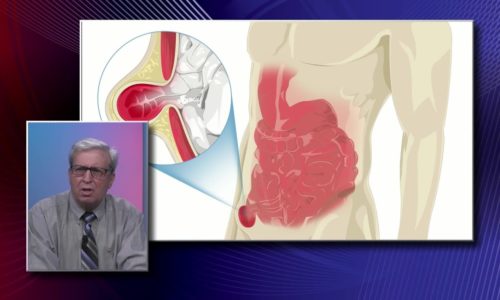Types of Hernias With Dr. Michael Renfrow |
A hernia can be inguinal, femoral, umbilical, incisional, epigastric, and hiatal. Dr. Michael Renfrow, General Surgeon with Baptist Health South Florida, says there are different types of hernias and they are based on their location.
He explains an inguinal hernia is a hernia in the groin. “30% of males will end up at some point in their life getting surgery for a inguinal hernia, typically on the right side.” He also says an umbilical hernia is a hernia in the belly button, and it is a natural weakness and defect from when you were in uterus and your umbilical cord was.
Transcript
I think actually we have a nice graphic we’re gonna we’re gonna pull up and maybe you can talk to us a little bit about the different types of hernias.> So yeah there’s different types of hernias and they’re really based on the location of the hernia as relative the abdominal wall, the first is there is an inguinal hernia, and that’s a hernia in the groin, 30% of males will end up at some point in their life getting surgery for a inguinal hernia typically on the right side, nobody knows why the right side is favored but more than often than not it is on the right side, a femoral hernia is almost in the exact location just about a centimeter below in England hernia, and that is actually more common in females, but it really is the same repair, the third type of her and you see there is referred to as an umbilical hernia and that’s a hernia in the belly button, and that’s really a natural weakness and defect from when you’re in utero and your umbilical cord was and many times there’s a hernia it’s probably greater than 50%, not all of those need to be repaired is they’re very small, but as they grow and they get to a certain size and especially they could become painful then you go ahead and do surgery, and those are usually the most straightforward repairs out of all of the hernias you can have, and incisional hernia typically is one of the more complicated hernias, that’s at any previous surgical site, so if you have a previous surgery in the past whether it’s for a colon resection stomach surgery, any point in your life whether it’s three days later or 20 years later, you’re always at risk at that area to get a hernia, and those journeys can be very large usually the worst ones are after gunshot wounds or a car accidents where you’ve had exploratory surgery and years later you get a giant hernia where the abdominal wall ends up with a giant hole.
A hernia can be inguinal, femoral, umbilical, incisional, epigastric, and hiatal. Dr. Michael Renfrow, General Surgeon with Baptist Health South Florida, says there are different types of hernias and they are based on their location.
He explains an inguinal hernia is a hernia in the groin. “30% of males will end up at some point in their life getting surgery for a inguinal hernia, typically on the right side.” He also says an umbilical hernia is a hernia in the belly button, and it is a natural weakness and defect from when you were in uterus and your umbilical cord was.
Transcript
I think actually we have a nice graphic we’re gonna we’re gonna pull up and maybe you can talk to us a little bit about the different types of hernias.> So yeah there’s different types of hernias and they’re really based on the location of the hernia as relative the abdominal wall, the first is there is an inguinal hernia, and that’s a hernia in the groin, 30% of males will end up at some point in their life getting surgery for a inguinal hernia typically on the right side, nobody knows why the right side is favored but more than often than not it is on the right side, a femoral hernia is almost in the exact location just about a centimeter below in England hernia, and that is actually more common in females, but it really is the same repair, the third type of her and you see there is referred to as an umbilical hernia and that’s a hernia in the belly button, and that’s really a natural weakness and defect from when you’re in utero and your umbilical cord was and many times there’s a hernia it’s probably greater than 50%, not all of those need to be repaired is they’re very small, but as they grow and they get to a certain size and especially they could become painful then you go ahead and do surgery, and those are usually the most straightforward repairs out of all of the hernias you can have, and incisional hernia typically is one of the more complicated hernias, that’s at any previous surgical site, so if you have a previous surgery in the past whether it’s for a colon resection stomach surgery, any point in your life whether it’s three days later or 20 years later, you’re always at risk at that area to get a hernia, and those journeys can be very large usually the worst ones are after gunshot wounds or a car accidents where you’ve had exploratory surgery and years later you get a giant hernia where the abdominal wall ends up with a giant hole.
A hernia can be inguinal, femoral, umbilical, incisional, epigastric, and hiatal. Dr. Michael Renfrow, General Surgeon with Baptist Health South Florida, says there are different types of hernias and they are based on their location.
He explains an inguinal hernia is a hernia in the groin. “30% of males will end up at some point in their life getting surgery for a inguinal hernia, typically on the right side.” He also says an umbilical hernia is a hernia in the belly button, and it is a natural weakness and defect from when you were in uterus and your umbilical cord was.
Transcript
I think actually we have a nice graphic we’re gonna we’re gonna pull up and maybe you can talk to us a little bit about the different types of hernias.> So yeah there’s different types of hernias and they’re really based on the location of the hernia as relative the abdominal wall, the first is there is an inguinal hernia, and that’s a hernia in the groin, 30% of males will end up at some point in their life getting surgery for a inguinal hernia typically on the right side, nobody knows why the right side is favored but more than often than not it is on the right side, a femoral hernia is almost in the exact location just about a centimeter below in England hernia, and that is actually more common in females, but it really is the same repair, the third type of her and you see there is referred to as an umbilical hernia and that’s a hernia in the belly button, and that’s really a natural weakness and defect from when you’re in utero and your umbilical cord was and many times there’s a hernia it’s probably greater than 50%, not all of those need to be repaired is they’re very small, but as they grow and they get to a certain size and especially they could become painful then you go ahead and do surgery, and those are usually the most straightforward repairs out of all of the hernias you can have, and incisional hernia typically is one of the more complicated hernias, that’s at any previous surgical site, so if you have a previous surgery in the past whether it’s for a colon resection stomach surgery, any point in your life whether it’s three days later or 20 years later, you’re always at risk at that area to get a hernia, and those journeys can be very large usually the worst ones are after gunshot wounds or a car accidents where you’ve had exploratory surgery and years later you get a giant hernia where the abdominal wall ends up with a giant hole.
A hernia can be inguinal, femoral, umbilical, incisional, epigastric, and hiatal. Dr. Michael Renfrow, General Surgeon with Baptist Health South Florida, says there are different types of hernias and they are based on their location.
He explains an inguinal hernia is a hernia in the groin. “30% of males will end up at some point in their life getting surgery for a inguinal hernia, typically on the right side.” He also says an umbilical hernia is a hernia in the belly button, and it is a natural weakness and defect from when you were in uterus and your umbilical cord was.
Transcript
I think actually we have a nice graphic we’re gonna we’re gonna pull up and maybe you can talk to us a little bit about the different types of hernias.> So yeah there’s different types of hernias and they’re really based on the location of the hernia as relative the abdominal wall, the first is there is an inguinal hernia, and that’s a hernia in the groin, 30% of males will end up at some point in their life getting surgery for a inguinal hernia typically on the right side, nobody knows why the right side is favored but more than often than not it is on the right side, a femoral hernia is almost in the exact location just about a centimeter below in England hernia, and that is actually more common in females, but it really is the same repair, the third type of her and you see there is referred to as an umbilical hernia and that’s a hernia in the belly button, and that’s really a natural weakness and defect from when you’re in utero and your umbilical cord was and many times there’s a hernia it’s probably greater than 50%, not all of those need to be repaired is they’re very small, but as they grow and they get to a certain size and especially they could become painful then you go ahead and do surgery, and those are usually the most straightforward repairs out of all of the hernias you can have, and incisional hernia typically is one of the more complicated hernias, that’s at any previous surgical site, so if you have a previous surgery in the past whether it’s for a colon resection stomach surgery, any point in your life whether it’s three days later or 20 years later, you’re always at risk at that area to get a hernia, and those journeys can be very large usually the worst ones are after gunshot wounds or a car accidents where you’ve had exploratory surgery and years later you get a giant hernia where the abdominal wall ends up with a giant hole.








